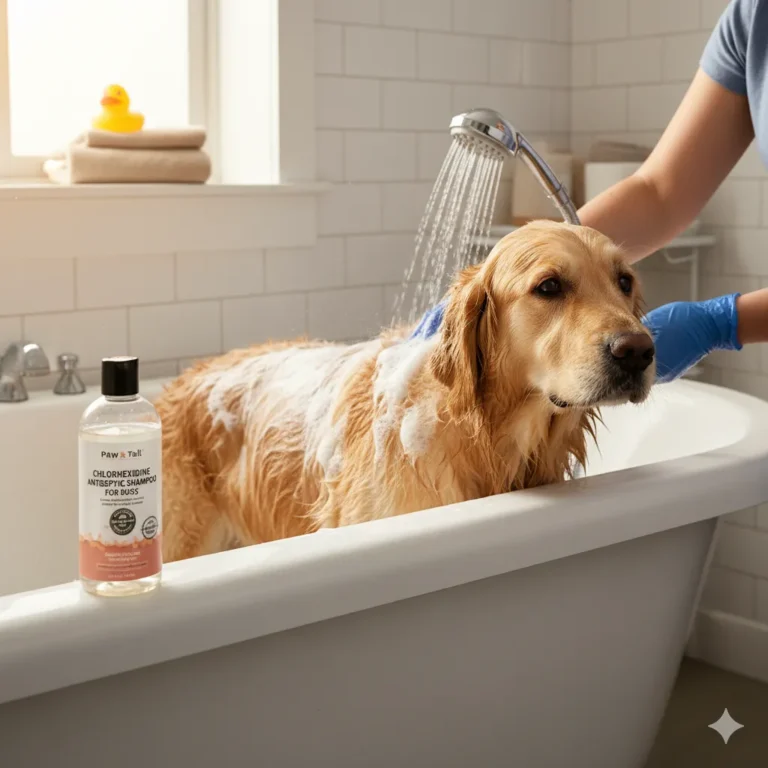
Decoding Chlorhexidine for Dogs: Your Go-To Guide for a Healthy Pup
Hey there, fellow dog lover! Let me paint you a picture. You’re having a cozy cuddle session with your furry best friend when you notice it… that smell. You know the one. It’s a little funky, coming from their ears or maybe their paws. Or perhaps they’ve been doing that frantic, foot-thumping scratch all afternoon, and you’ve spotted a red, angry-looking patch on their skin.
Your heart sinks a little, right? You want to help, but where do you even start? If you’ve done a quick online search for solutions, your screen has probably been flooded with one word: chlorhexidine. It sounds like something you’d need a lab coat to pronounce, doesn’t it? I totally get it. When my own dog, Barnaby, had his first bout with a gnarly skin infection, I felt the same wave of confusion and worry.
But here’s the good news: what if I told you that this scientific-sounding stuff is actually one of the most trusty tools in a dog parent’s first-aid kit? Think of me as your friendly neighborhood dog-obsessed blogger, here to have a coffee-chat and break it all down for you. We’re going to decode the mysteries of chlorhexidine together—what it is, when to use it, and how to do it safely. Consider this your ultimate, no-jargon guide to feeling confident and empowered about your pup’s skin health. Let’s get into it!
Understanding Chlorhexidine and Its Uses
Alright, let’s kick things off by getting to know our star player. Chlorhexidine isn’t some scary, alien chemical; it’s more like the superhero of the antiseptic world, specially suited for our four-legged friends.
What is chlorhexidine and how does it work for dogs?
In simple, tail-wagging terms, chlorhexidine is a powerhouse antiseptic and antimicrobial agent. Fancy words, but all they mean is that it’s incredibly good at hunting down and taking out the tiny troublemakers—like bacteria, yeast, and fungi—that love to cause skin and ear infections in our pups.
Here’s the really cool part: how it works. Imagine those bad-guy microbes are trying to build a little fortress on your dog’s skin. Chlorhexidine swoops in and basically melts the mortar between their bricks. It binds to their cell walls and makes them all leaky, which is a very bad day for them and a very good day for your itchy dog! Even better, it has this awesome “residual effect.” It’s like leaving a friendly guard dog on patrol; it sticks around on the skin for hours, sometimes even days, after you rinse it off, continuing to protect your pup.
What conditions is chlorhexidine typically used to treat in dogs?
So, when does this superhero get called into action? Vets often reach for chlorhexidine when our dogs are dealing with:
- Pyoderma: This is a bacterial skin infection that shows up as those red, itchy, sometimes pimple-like bumps. Super common, especially in our allergy-prone buddies.
- Malassezia Dermatitis (Yeast Infections): If your dog smells a bit like corn chips or has greasy, red-brown skin (especially in those adorable toe webs and skin folds), you’re probably dealing with yeast. Chlorhexidine is a yeast-fighting champ!
- Hot Spots (Acute Moist Dermatitis): Those angry, red, wet sores that seem to appear out of nowhere? Chlorhexidine is perfect for cleaning them up and stopping bacteria in their tracks.
- Folliculitis: A fancy word for inflamed hair follicles.
- Surgical Site Prep: This is a big one! Vets use it to disinfect skin before surgery to keep everything super clean.
- Wound Care: For minor scrapes and cuts, a little diluted chlorhexidine can help prevent infection.
- Ear Infections: Certain ear flushes with chlorhexidine can help tackle bacteria and yeast partying in your dog’s ears.
Dr. Sarah Johnson, a board-certified veterinary dermatologist at Pet Dermatology Specialists , puts it perfectly: “Chlorhexidine is a cornerstone in managing many dermatological issues, especially those complicated by secondary bacterial or yeast overgrowth. It’s invaluable for breaking the cycle of infection and inflammation.”
Is chlorhexidine an antibiotic?
This is a question I get all the time! And it’s a really important distinction. While chlorhexidine is a bacteria-busting rockstar, it’s not technically an antibiotic.
Think of it this way: antibiotics are like specialized snipers that target specific processes inside bacteria. They’re often systemic (working from the inside out) and can lead to resistance if overused. Chlorhexidine, on the other hand, is an antiseptic. It’s more like a broad-spectrum bouncer that works topically on the skin’s surface, wrecking the cell membranes of a wide range of microbes. This different approach makes resistance much less likely, which is why it’s such a fantastic first line of defense!
What are the benefits of using chlorhexidine for my dog?
Why do vets and dog experts (and me!) love this stuff so much? Let me count the ways:
- Broad-Spectrum Efficacy: It takes on bacteria, yeast, and fungi. Talk about a multi-tasker!
- Residual Activity: It keeps working long after you’ve put the shampoo bottle away.
- Fast-Acting: It gets to work quickly to give your pup relief.
- Odor Fighter: Bye-bye, stinky dog smell! It targets the microbes causing the funk.
- Healing Helper: By controlling the infection, it lets your dog’s skin do its natural healing thing.
- Widely Available: You can find it over-the-counter or at your vet’s office—easy peasy.
Can chlorhexidine be used for routine cleaning or maintenance?
For a dog with perfectly healthy skin, a gentle, moisturizing shampoo is usually all you need for bath time. You don’t want to overdo it and risk drying out their skin.
But, for my pups who are prone to issues—like our wrinkle-faced friends (looking at you, Bulldogs!), or dogs with allergies or chronic yeast problems—a maintenance schedule with a chlorhexidine shampoo or wipes can be a total game-changer. It’s like preventative care! Always, always check with your vet first to see if a maintenance routine is right for your specific dog.
Application and Administration
Okay, so we know why it’s great. Now let’s talk about the how. Using it correctly is the key to making it work like a charm.
How do I properly apply chlorhexidine to my dog (shampoo, wipes, spray)?
The method depends on the product and the problem spot!
chlorhexidine shampoo for dogs:
This is your go-to for full-body issues.
- Get Them Soaked: Thoroughly wet your dog’s coat with nice, warm water. Make sure you get past that top layer of fur!
- Lather Up!: Apply the shampoo generously and work it into a rich, luxurious lather. Really focus on the problem areas, but for widespread issues, a full-body sudsing is best.
- Massage It In: This isn’t just a spa moment (though your pup might think so!). Gently massage it down to the skin to make sure the chlorhexidine makes contact where it’s needed.
- The Secret Step: CONTACT TIME: This is the most common mistake, so listen up! For chlorhexidine to work its magic, it needs to sit on the skin for 10-15 minutes. I know, it sounds like forever with a wiggly dog! Set a timer, give them a lick mat or a favorite chew toy, and be patient. This step is non-negotiable for effectiveness. (example link: www.vetfolio.com/chlorhexidine-use-guide)
- Rinse, Rinse, Rinse: After the time’s up, rinse until the water runs completely clear. Any leftover residue can irritate the skin.
- Towel Dry: Pat your sweet pup dry with a clean, soft towel.
chlorhexidine wipes for dogs:
Perfect for targeted trouble zones like skin folds, paws, or bums.
- Wipe the Area: Gently wipe the affected spot, making sure you’re getting onto the skin itself.
- No Need to Rinse: The beauty of wipes is that they’re leave-on, so the protection continues.
- Follow Vet’s Orders: Your vet will tell you how often to use them.
Sprays:
Ideal for hot spots or small cuts.
- Clean First: If you can, gently clear any gunk from the area.
- Spray Away: Apply the spray directly until the skin is moist.
- Let it Dry: No rinsing needed here, either. Just try to distract your dog from licking it off until it dries (a cone of shame might be necessary for determined lickers!).
How often should I use chlorhexidine on my dog?
This totally depends on what you’re dealing with.
- Active Infection: Your vet might suggest bathing every 2-3 days to start.
- Maintenance Mode: Once the worst is over, this might drop to once a week or every other week.
- Wipes/Sprays: These can often be used daily, or even twice a day, for specific spots.
Your vet’s instructions are your bible here—they’ll give you a schedule tailored just for your dog.
How long should I leave chlorhexidine shampoo on my dog before rinsing?
I’m going to sound like a broken record because this is so important: 10 to 15 minutes. Don’t skip this! It’s what makes all the difference.
Can I use human chlorhexidine products on my dog?
I’m gonna give you a firm but friendly no on this one. Here’s why:
- Concentration is Key: Human products can be too strong or too weak for our pups.
- Mystery Ingredients: They often have extra fragrances, dyes, or other stuff that could irritate your dog’s more sensitive skin.
- Made for Dogs: Veterinary formulas are specifically designed for a dog’s skin pH and coat.
Stick to the dog-specific stuff. It’s just safer and more effective.
What is the correct concentration of chlorhexidine for dogs?
You’ll typically find it in 2% to 4% concentrations.
- 2%: The all-star for most common skin and yeast issues. It’s strong but usually very well-tolerated.
- 4%: Reserved for the really tough, stubborn infections.
Your vet will tell you which concentration is the right tool for the job. No guessing!
Can I dilute chlorhexidine solution for my dog? If so, how?
This is a “only if your vet says so” situation. Diluting it wrong can make it useless or still too harsh. Unless your vet gives you exact, step-by-step instructions (e.g., “mix one part of this 4% solution with ten parts sterile water”), please don’t do it yourself. Use the product as it was manufactured.
Safety and Side Effects
Let’s talk safety! Because even the best tools need to be used wisely.
Is chlorhexidine safe for dogs?
Yes! When used as directed by your vet, chlorhexidine is generally very safe for dogs. It’s poorly absorbed through the skin, so it mostly stays where you put it, which minimizes risks. It’s a trusted, well-studied ingredient that has helped countless dogs.
What are the potential side effects of chlorhexidine in dogs?
Side effects are rare, but it’s good to know what to look for:
- Skin Irritation/Redness: The most common one. Some sensitive pups might get a little red or itchy. This usually calms down once you stop using the product.
- Dryness: It can be a little drying, especially with frequent baths. Using a shampoo with added moisturizers can help.
- Temporary Staining: Very rarely, it might cause a slight brown tint on light-colored fur, but it usually washes out.
- Allergic Reaction: This is extremely rare, but watch for things like hives, swelling, or trouble breathing, which need immediate vet attention.
What happens if my dog licks or ingests chlorhexidine?
We’ve all been there—the second you turn around, they’re licking the spot you just treated!
- A Little Lick: If they just get a tiny bit from their fur, it’s usually not a big deal. It tastes bitter, so that often stops them. They might have a minor upset tummy, but it typically passes quickly.
- A Big Gulp: If they actually drink from the bottle, that’s more serious. It could cause significant stomach upset or even esophageal irritation.
What to do: Stay calm. Check the product label. Then, immediately call your vet or a pet poison helpline. (Example link for Pet Poison Helpline: www.petpoisonhelpline.com) or ASPCA Animal Poison Control Center (example link: www.aspca.org/pet-care/animal-poison-control). Do not make your dog vomit unless a professional tells you to.
Can chlorhexidine cause skin irritation or dryness?
It can, which is why it’s so important to follow directions. If you see irritation, ease up on how often you’re using it. For dryness, look for a formula with soothing ingredients like oatmeal or ask your vet about a conditioner.
Is it safe to use chlorhexidine near my dog’s eyes, ears, or mouth?
We have to be super careful here:
- Eyes: NO. Keep it far away from their eyes. It can cause serious irritation and damage. If you get any in there, flush with lots of water and call your vet.
- Ears: YES, but only with the right product. Use only ear cleaners specifically formulated with chlorhexidine for dogs. Do NOT put shampoo in their ears! And always have a vet check first to make sure the eardrum is intact.
- Mouth: Only with specific products. There are chlorhexidine oral rinses for dental health. Never use skin products in your dog’s mouth.
Are there any dogs that should not use chlorhexidine (e.g., pregnant, puppies, specific breeds)?
It’s generally safe for most, but we should be extra thoughtful with:
- Puppies: Usually okay, but often with a milder product and a vet’s guidance.
- Pregnant/Nursing Moms: Best to check with your vet first to be safe.
- Dogs with Known Sensitivities: If your dog has reacted to it before, obviously avoid it.
- Dogs with Ruptured Eardrums: A big no-no for ear cleaning until the eardrum is healed.
Your vet is your best guide for your dog’s unique situation.
What should I do if my dog has an adverse reaction to chlorhexidine?
If your pup has a bad reaction—severe redness, swelling, vomiting, etc.:
- Stop using the product.
- Rinse the area with plenty of cool water.
- Call your vet right away. Describe what happened. For severe symptoms like difficulty breathing, go to the emergency vet immediately.
Specific Conditions and Concerns
Let’s get specific about some common problems where chlorhexidine really shines.
Can chlorhexidine treat yeast infections in dogs?
A resounding YES! It’s a superstar against that classic yeast (Malassezia) that makes our dogs smell like Frito feet and get all red and itchy. A good chlorhexidine shampoo with that crucial contact time can dramatically reduce the yeast population and bring your pup so much relief.
Is chlorhexidine effective against hot spots?
100% yes. Hot spots are miserable, wet, and painful. Chlorhexidine is perfect for them because it cleanses the area, fights bacteria, and has a slight drying effect. A spray or wipe is often the best delivery method for these targeted sores.
Can chlorhexidine help with allergies or itchy skin?
Here’s the deal: chlorhexidine doesn’t cure allergies. Allergies are an internal immune response.
But! All that scratching from allergies breaks the skin and lets bacteria and yeast waltz right in, making the itching infinitely worse. This is where chlorhexidine saves the day. By knocking out those secondary infections, it reduces the itch, helps the skin heal, and breaks the awful “itch-scratch” cycle. It’s a key player in managing allergy symptoms, even if it doesn’t fix the root cause.
Can I use chlorhexidine to clean my dog’s ears or paws?
- Paws: Absolutely! Wipes or a diluted foot soak are fantastic for keeping paws clean, especially for dogs who lick their paws or have allergies. It’s a great way to wipe away allergens after a walk.
- Ears: Yes, but I’ll say it again—only use an ear cleaner that is specifically labeled for canine ears and contains chlorhexidine. Never, ever put shampoo inside the ear canal.
How does chlorhexidine compare to other antiseptic treatments for dogs?
Let’s do a quick showdown:
- vs. Povidone-Iodine (Betadine): Also good, but it can stain and has less staying power than chlorhexidine.
- vs. Hydrogen Peroxide: Just don’t. It’s too harsh on healthy skin cells and can actually slow down healing. Leave this one for first aid kits, not for routine skin care.
- vs. Benzoyl Peroxide: Great for deep cleaning follicles and has antimicrobial power, but it can be much more drying and irritating than chlorhexidine.
The Verdict: Chlorhexidine often wins for its broad-spectrum power, great residual activity, and general gentleness on canine skin.
General Information
Let’s wrap up with some quick, practical tips.
Do I need a prescription to get chlorhexidine for my dog?
Nope! Most topical chlorhexidine products (shampoos, wipes, sprays) are available over-the-counter. Your vet might recommend a specific brand, but you usually don’t need a script. Of course, for oral medications or severe cases, you will.
Where can I buy chlorhexidine products for dogs?
You’ve got options!
- Your Vet’s Office: The best place for a trusted recommendation.
- Pet Supply Stores: They carry a great selection.
- Online: Chewy, Amazon, etc. Just buy from reputable sellers.
How should I store chlorhexidine products?
Easy!
- In a cool, dry place.
- WAY out of reach of pets and kids. (Seriously, lock it up!).
- With the lid on tight.
- And always check the expiry date before using it.
When should I consult a veterinarian before using chlorhexidine?
Even though it’s OTC, please call your vet if:
- This is a brand-new, undiagnosed skin issue.
- The problem is severe, painful, or spreading fast.
- It involves the ears (get that exam first!).
- It’s a deep wound.
- Your dog is a puppy, pregnant, or has other health issues.
- You’re just not sure!
Your vet is your partner in this. They can make sure you’re tackling the right problem with the right solution, so your best friend can get back to their happy, healthy, tail-wagging self as fast as possible.
related:
dog yeast infection home remedy: ACV & coconut oil
Decoding hot spot on dog: Causes & Cures
Puppy Strangles: Your Guide to Juvenile Cellulitis
Dog Rash on Belly: Causes and Fixe
please leave comment
you may like it





sources
- https://www.petmd.com/dog/care/chlorhexidine-dogs-what-you-need-know
- https://pmc.ncbi.nlm.nih.gov/articles/PMC11903347/?
- https://www.ellevetsciences.com/blog/what-is-chlorhexidine-for-dogs
- https://www.veterinarypracticenews.com/the-pros-and-cons-of-scrubbing-with-betadine-chlorhexidine
- https://vetsandclinics.com/en/chlorhexidine-use-in-dogs?
- https://vcahospitals.com/know-your-pet/pyoderma-in-dogs
- https://www.akc.org/expert-advice/health/yeast-infection-dogs/
- https://vcahospitals.com/know-your-pet/chlorhexidine-topical?
- https://www.vetdermspecialists.com/
- https://www.petplace.com/article/drug-library/drug-library/library/chlorhexidine-for-dogs-and-cats
- https://www.dvm360.com/
- https://www.petpoisonhelpline.com/
- https://www.aspca.org/pet-care/animal-poison-control
- https://todaysveterinarypractice.com/dermatology/chlorhexidine-skin-disease-dogs-cats/
- https://veterinarypartner.vin.com/default.aspx?pid=19239&id=4952549
- https://www.merckvetmanual.com/pharmacology/antimicrobial-agents/antiseptics-and-disinfectants

